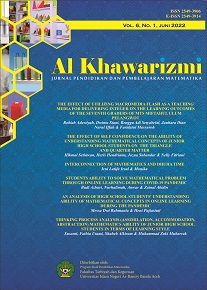Thinking Process Analysis (Assimilation, Accommodation, Abstraction) Mathematics Ability of Junior High School Students in terms of Learning Style
DOI:
https://doi.org/10.22373/jppm.v6i1.12329Keywords:
Thinking Process, Literacy Ability, Learning StyleAbstract
The purpose of this research is to know the thinking processed of student’s mathematical literacy abilities in terms of auditory, visual and kinesthetic learning styles. This research is an exploratory study with a qualitative approach. This research was conducted in Junior High Schools classified as Excellent in Meulaboh Regency. The subjects in this study were students of class IX MTsN 3 Aceh Barat who had the high-level ability and were able to solve math literacy problems, besides the subject was also chosen based on learning styles. The results showed that there was no significant difference in students mathematical literacy thinking processes based on visual learning styles is the process of assimilation and abtarksi thinking. Subjects with auditory learning styles, the thought processes of accommodation and abstraction for the kinesthetic learning styles, the processes of thinking, assimilation and abstraction.
References
Bire, A. L., Geradus, U., & Bire, J. (2014). Effects of Visual, Auditorial, and Kinesthetic Learning Styles on Student Learning Achievement. Jurnal Kepaendidikan, 44(2), 168–174.
Chasanah, A. N., Wicaksono, A. B., Nurtsaniyah, S., & Utami, R. N. (2020). Analisis Kemampuan Literasi Matematika Mahasiswa pada Mata Kuliah Statistika Inferensial Ditinjau dari Gaya Belajar Analyze The Students ’ s Mathematics Literacy Abilities in Inferenstial Statistics Subject Based on the Learning Styles. Edumatica Jurnal Pendidikan Matematika, 10(September).
Marwan, M. Ikhsan, M. (2019). Peningkatan Kemampuan Berfikir Kritis Matematis Siswa Melalui Model Pembelajaran Berbasis Masalah. Symmetry: Pasundan Journal of Research in Mathematics Learning and Education, volume 4, 9–18. https://doi.org/10.23969/symmetry.v4i2.2085
Sen, A., Mai, T., Kastberg, D., Cummings, L., & Perkins, R. (2019). Highlights of U.S. PISA 2018 Results Web Report. In National Center for Educational Statistics. https://nces.ed.gov/pubsearch/pubsinfo.asp?pubid=2020166
Setiana. (2020). Pengaruh Gaya Belajar terhadap Prestasi Belajar Siswa. Jurnal Fakultas Keguruan & Ilmu Pendidikan, 1(1), 50–58.
TIMSS, P. &. (2019). About TIMSS 2019. In Boston Collage. https://timssandpirls.bc.edu/index.html
Widayanti, F. D. (2013). Pentingnya Mengetahui Gaya Belajar Siswa Dalam Kegiatan Pembelajaran Di Kelas. Erudio Journal of Educational Innovation, 2(1). https://doi.org/10.18551/erudio.2-1.2
Bire, A. L., Geradus, U., & Bire, J. (2014). Effects of Visual, Auditorial, and Kinesthetic Learning Styles on Student Learning Achievement. Jurnal Kepaendidikan, 44(2), 168–174.
Chasanah, A. N., Wicaksono, A. B., Nurtsaniyah, S., & Utami, R. N. (2020). Analisis Kemampuan Literasi Matematika Mahasiswa pada Mata Kuliah Statistika Inferensial Ditinjau dari Gaya Belajar Analyze The Students ’ s Mathematics Literacy Abilities in Inferenstial Statistics Subject Based on the Learning Styles. Edumatica Jurnal Pendidikan Matematika, 10(September).
Marwan, M. Ikhsan, M. (2019). Peningkatan Kemampuan Berfikir Kritis Matematis Siswa Melalui Model Pembelajaran Berbasis Masalah. Symmetry: Pasundan Journal of Research in Mathematics Learning and Education, volume 4, 9–18. https://doi.org/10.23969/symmetry.v4i2.2085
Sen, A., Mai, T., Kastberg, D., Cummings, L., & Perkins, R. (2019). Highlights of U.S. PISA 2018 Results Web Report. In National Center for Educational Statistics. https://nces.ed.gov/pubsearch/pubsinfo.asp?pubid=2020166
Setiana. (2020). Pengaruh Gaya Belajar terhadap Prestasi Belajar Siswa. Jurnal Fakultas Keguruan & Ilmu Pendidikan, 1(1), 50–58.
TIMSS, P. &. (2019). About TIMSS 2019. In Boston Collage. https://timssandpirls.bc.edu/index.html
Widayanti, F. D. (2013). Pentingnya Mengetahui Gaya Belajar Siswa Dalam Kegiatan Pembelajaran Di Kelas. Erudio Journal of Educational Innovation, 2(1). https://doi.org/10.18551/erudio.2-1.2

